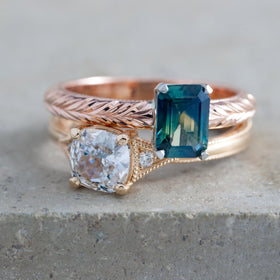
The Techniques and Terminology of Jewellery Making!
What is the difference between handmade, handcrafted, assembled, or curated jewellery?
Hi everyone! We have been noticing the jewellery terms Handcrafted, Handmade, etc. used interchangeably online recently and thought we could shed some light of what they specifically mean and how they can affect pricing, and availability to pieces of jewellery.
Here are some of the techniques or terminology associated with jewellery making:
Handmade - This is a very specific term in the jewellery industry. Handmade pieces of jewellery are hand fabricated/forged without the aid of CAD, casting or pre-made parts. The gold, silver, or platinum is melted down, rolled into plate or wire, and formed with hand tools. The setting for the gemstones are custom made for each stone, and surface textures are added by hand. Handmade pieces of jewellery are sought after for their rarity, the skill involved to create these pieces, and the generally high quality. These pieces are usually made one at a time, which can affect the availability - expect these pieces to take longer to create!
Handcrafted - This term for jewellery creation refers to the idea that there are many tools to make a piece of jewellery. Makers of handcrafted jewellery frequently use a combination of casting, forging, and CAD. They custom create the settings for gemstones and add textures to the metal surface by hand. The concept for the creation of these pieces is their own, and they use whatever tools that suit the project to complete it. These pieces can be one-of-a-kind or made in multiples. They can also be quite complex - several people with specialized skills may end up working on one piece of jewellery.
Assembled - Many jewellery items such as earrings are created with pre-made parts. The reason for this is because some parts or findings are very time consuming or expensive to produce. Some examples of these parts are earring backs, chains, earring posts, settings for stones, or tiny hinged parts. Many designers will buy pre-made parts to solder to a handcrafted ring and then set the stones. Or the designer will choose the stones to go into a new pair of earrings, order the parts, and assemble them. This style of jewellery making can be quicker to produce, and less costly than handmade and handcrafted jewellery.
Curated Collection - These are pre-made, finished pieces of jewellery bought from a catalogue or a jewellery wholesaler. This represents over 95% of jewellery available in retail stores. Retailers will choose pieces based on the look and feel of their store, but do not choose many of the stones already set into the piece of jewellery. There are usually multiples available of these pieces and they may not be made in the city they are sold in.
This list is not meant to imply one style of jewellery making is better than another. There is no wrong way to make jewellery - designers and goldsmiths should use whatever tools they enjoy to make pieces! There are beautiful items of jewellery that are high quality in every style listed above.
When purchasing a new piece, look for a design you love with quality gemstones and metalwork that will last for years. Check with the retailer about warranties, and if they cover cleanings and repairs to the new piece of jewellery.
We hope this clarification of terminology will help to educate and inform customers about the different techniques of jewellery making!



Comments
Leave a comment